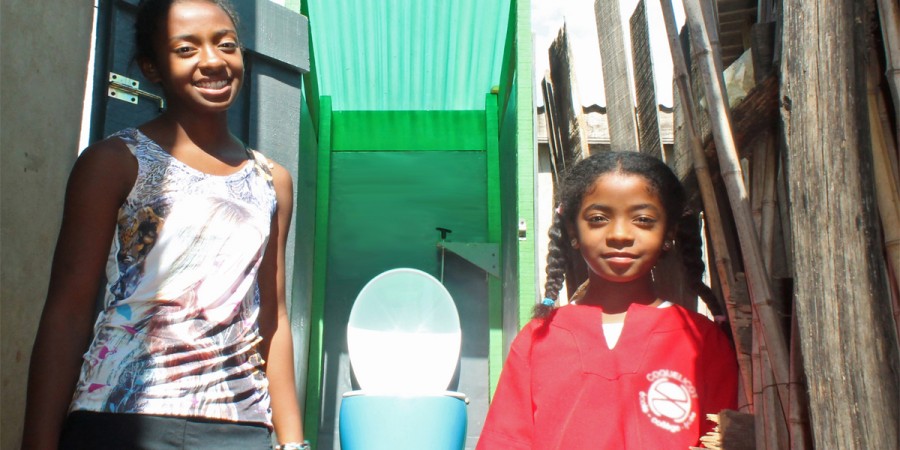Imagine it is dark outside, you need to use the toilet, and your choices are:
1 Going to a pit latrine nearby that is overflowing, slippery, and easy to fall into.
2 Travel much further to the toilets risking attacks and, if you are a woman, rape.
3 Using the closet yard, spreading harmful pathogens where children play everyday.
4 Venture into the bush were you may be bitten by wild animals, snakes or scorpions.
This is not a trick question. The humbling and troubling reality is that there are few good sanitation options for people living in humanitarian emergencies. The situation is worse for women and children, but it is a major concern for the whole community sharing facilities and trying to stay healthy. And of course these are people already surviving a crisis such as famine, flooding, earthquake or war, and coping with many compounding pressures on their physical and mental health.
For many of us it is upsetting to learn that diarrhoea remains one of the three most common killers of young children globally, along with pneumonia and malaria. It is thought that more than half of these deaths could be prevented by clean water, sanitation and good hygiene.
Today is “World Toilet Day” co-ordinated by UN-Water in collaboration with many stakeholders. As well as raising awareness about the importance, scale and complexity of the current problem, it is a perfect day to highlight some of the positive efforts being made to improve the situation. We take this opportunity to celebrate the innovators that are driving the way forwards for better sanitation and health.
At the Humanitarian Innovation Fund we run a special fund dedicated to supporting creative problem-solving for water, sanitation and hygiene (WASH) needs in emergencies. We are always on the look-out for teams and partnerships with the skills, knowledge, networks and, of course, strong motivation to build better sanitation options. By better options we mean ones that are safer, more cost effective, and protect privacy and dignity.
Here are some of the current projects we are supporting, and are really excited about. Watch this space as the ideas are tested and iterated, and most importantly we ask innovators to share their insights and learnings along the way, some of which you can find on our project blog pages.
1. Bio and chemical additives to make latrines and toilets safer and easier
In urban settings where space is limited and a lot of people are living in close proximity, latrines fill up very quickly and pose a major health hazard. For years people have thought that adding simple things like lime, lactic acid or soda to toilets can help make latrines safer, smell better, and ideally even reduce the volume so that the pit latrine or toilet “never fills up” or at least lasts much longer. The non-profit advisers or urban environment and development, WASTE, are leading a project in collaboration with the London School of Tropical Medicine and Hygiene (LSHTM) to investigate how much truth there is behind these assumptions, testing out various bio and chemical additives, as well as analysing different toilet samples from across the globe. As I write this the WASTE team have just returned from another field trial working closely with a local laboratory in Malawi, and will soon be reporting back with their latest insights.
2. Waterless toilets that also charges your mobile phone
You may have noticed that waterless toilet technologies are on the rise, not least in western contexts like festival “portable loos”. Loowatt is a social enterprise pioneering this technology and they can see how these toilets might be very useful in emergency contexts such as flood areas, or urban centres when it is not possible or smart to use water. Going one step further, what if the waste matter could be treated to remove pathogens and generate energy and fertiliser products? To explore the potential we are supporting Loowatt to collaborate with humanitarian agencies and investigate how to implement such technologies in the middle of a crisis.
3. Exploring private sector sanitation services in an urban emergencies
Public-private partnerships provide sanitation services around the world, but rarely do we find enterprises in an emergency setting working alongside humanitarian agencies and disaster-affected communities. Would such enterprises be able to provide a better quality service, and sustainable end-end waste management, at a lower cost? Few business models for this have been tested out at scale. We are supporting a partnership project between social enterprise, Sanergy, and the international humanitarian agency, GOAL, to generate learning and evidence for how this can be achieved. Currently they are prototyping a waste transfer station in Nairobi that is designed for crowded urban disasters.
4. Lighting up toilets to make them safer to use at night
One of the main reasons why women and girls leave their shelters at night is to use the toilet, and in focus groups they regularly share how unsafe they feel. Doors, locks and lighting are among their top requests. However humanitarian agencies find that lighting systems are easily vandalised, stolen, or fail to stand up to the harsh realities of operating in an ongoing displacement crisis. Following our open innovation competition last year, we are now supporting the development of a practical solution for this that uses falling weight and pulley-systems within a “vandal-proof” tube powering an LED light. The idea is that a few seconds of lifting the weight could generate 20-30minutes of lighting. While the technology is promising the design agency working on this are keen to understand how the community will perceive and interact with these lights in practice.
And so the list goes on! Here’s to those who care enough about this problem to get their wellies on, and work on solutions together. We at the Humanitarian Innovation Fund are honoured to work with such inspiring people, and hope to continue taking risks to support ideas that might just prove to transform how people use toilets in humanitarian crises.


Comments